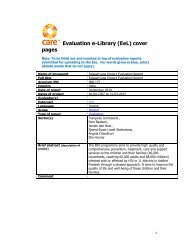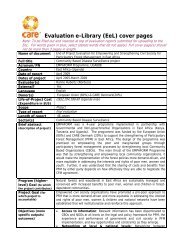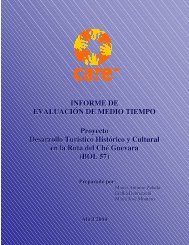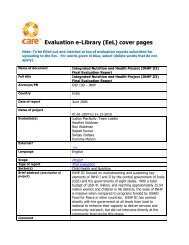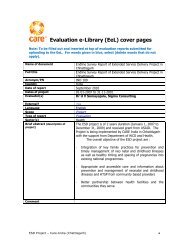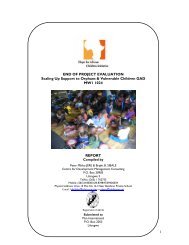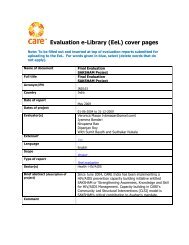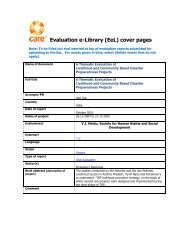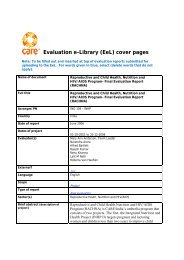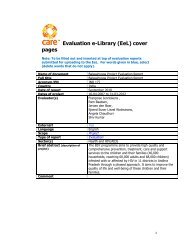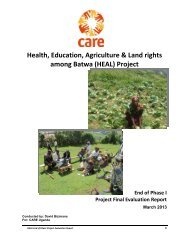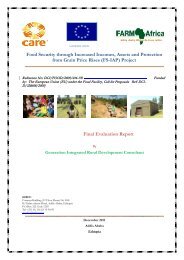IND 199 ECDE Baseline - CARE International's Electronic ...
IND 199 ECDE Baseline - CARE International's Electronic ...
IND 199 ECDE Baseline - CARE International's Electronic ...
- No tags were found...
You also want an ePaper? Increase the reach of your titles
YUMPU automatically turns print PDFs into web optimized ePapers that Google loves.
lxii80 CHAPTER – VII81 DEVELOPMENT TEST OF CHILDREN AGED 3-3.5 YEARS AND SCHOOLREADINESS OF CHILDREN AGED AND 5-5.5 YEARSThis chapter has been divided into two sections. The first section deals with children aged 3-3.5 years. These children were given an ICMR development screening test that included anumber of milestones achieved by children aged 3-3.5 years under components of grossmotor; vision and fine motor; hearing, language & concept development; self help skills andsocial skills. Through this test, it was assessed whether the child had achieved thesemilestones or not. To assess their nutritional status, both weight and height measurementswere obtained for each child.The second section of this chapter deals with children aged 5-5.5 years. They were tested forschool readiness through administering a school readiness instrument. This instrument hadtwo parts. In the first part, these children were tested for their achievements in pre –mathematical concepts, number concepts and language skills & reading readiness by showingvarious pictures under each of 10 activities. In the second part, they were assessed on thebehavioural aspects by asking a series of questions to their mother / care giver. In addition,both their weight and height measurements were taken to assess their nutritional status. Thischapter presents only the highlights along with the summary tables. For more detailedfindings , Tables 7.1A to 7.38A in Annexure – 2 may be referred.82 7.1 Children aged 3-3.5 years7.1.1 Profile of children aged 3-3.5 yearsAbout half of them in intervention districts were male, while 47 percent of them were male incontrol district. More than 90 percent of them belonged to SC/ST or OBC. In most of the cases(98% in intervention districts and 92% in control district), the mother of the child was therespondent. In case of those where caregiver was the respondent , they were mostly grandmother of the child. About 54 percent of children in intervention districts and 64 percent incontrol district were administered an ICMR screening test at AWC (Table 7.1A in Annexure -2).7.1.2 Milestones achieved by children aged 3-3.5 yearsGross motor• More than two – thirds of the children could “stand on one foot with help”, “walkbackwards”, “get up from squatting position with out help” and “touch opposite ear bytaking hand over the head”.• About two – fifths in intervention districts and one – half in control district were able “tocarry a wooden block on head and walk 5 steps”, while about one – half in bothintervention and control district could hop on one foot”.• Overall achievement of milestones is marginally better among female than male childrenin both intervention and control district. It is also marginally better among SC and OBCthan ST children in intervention & intermediate AWCs, but it is better among SC/ST thanOBC children in control AWCs (Tables 7.2A – 7.4A in Annexure -2).Vision & fine motor• More than 80 percent of the children could be able “to pick up cube/ pebble / marble” , “to attempt imitation of scribble”, “to draw a straight line in imitation” and to thread one<strong>Baseline</strong> Study Of Early Childhood Care And Development Project In ChattisgarhApril,2012



